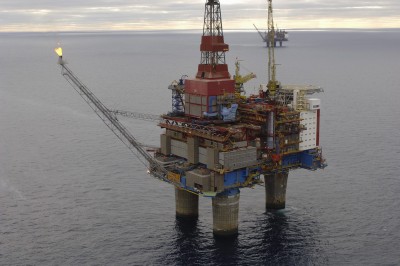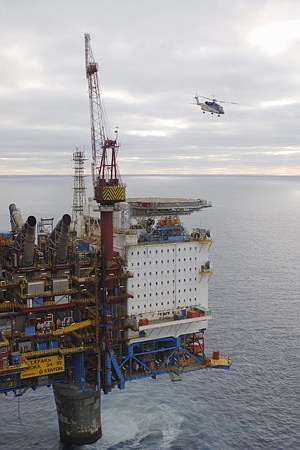As grim work continued in the aftermath of Friday’s helicopter crash near Bergen, Norwegian police could release the identities on Monday of eight of its victims. Oil production has resumed on the offshore oil platform where they’d been working, but officials warned that both the identification process and their investigation into the cause of the crash were “demanding” and would take time.

A total of 13 people died in the crash of the Airbus Super Puma E225 Helicopter as it flew in for landing at Bergen’s Flesland airport. They included 12 men and one woman, aged 32 to 60, 11 of whom were Norwegian. They’d been working on board Statoil’s Gullfaks B oil rig in the North Sea and were returning home on a routine flight from the platform, when the helicopter’s rotor suddenly broke away from the aircraft, which then plunged into the rocks and sea around the island of Turøy.
Investigators from several countries, including experts from Airbus and Canadian helicopter operator CHC Helicopter Service have been called in to probe the cause of what’s widely believed to be a fatal technical problem. Newspaper Dagens Næringsliv (DN) reported Monday that there have been more reports lately of serious and unexpected incidents tied to helicopter traffic after oil prices started to fall two years ago and the entire oil and offshore industry went into a downturn. CHC’s chief in Norway, Arne Roland, strongly denies that harder economic times have compromised helicopter maintenance or safety.
Now CHC itself has lost two of its pilots who were flying the helicopter on Friday, and both the company and helicopter manufacturer Airbus also face the prospect of technical failure and possible weakness in routines. Roland and his colleagues face many questions based on eyewitness reports that aircraft parts broke loose before the helicopter crashed, and over how cutbacks in the oil industry have battered CHC’s finances both at its Canadian parent company and its Norwegian subsidiary.

Roland denied that cost-cutting has undermined safety procedures: “It is our duty to make sure that safety is in place, otherwise I would have halted operations,” Roland told DN. Norwegian aviation authorities also claimed that safety requirements in the country’s large offshore helicopter business were high. “In general terms, I would say that there’s been good development within safety for many years,” Stein Erik Nodeland of aviation authority Luftfartstilsynet,” said over the weekend.
As the investigation proceeds, aided by the recovery of both data and flight recorders, production at Statoil’s Gullfaks field started up again on Sunday, at the request of workers. “They indicated they wanted to return to everyday routines,” a Statoil spokesman told state broadcaster NRK. The first flight carrying workers from the platform also landed safely on Sunday evening, amidst reports that more workers are now nervous about their obligatory helicopter commuting. One of the labour unions representing them, itself called SAFE, reported Monday that it expected more offshore workers would seek work elsewhere, to avoid it.
In addition to the 11 Norwegians on board the doomed helicopter were pilot Michele Vimercati, age 44, an Italian citizen living in Bergen who worked for CHC, and Iain Andrew William Stuart, age 41, from Scotland who’s survived by his wife and two children living in Laurencekirk in Kincardineshire. He worked for Halliburton.
For a preliminary list of the identities of crash victims, click here.
Many were calling the helicopter crash a national tragedy in Norway, not least because of the importance of the country’s offshore oil and gas industry that requires helicopter traffic. Flags flew at half-staff in Bergen over the weekend, also at companies involved in the crash.
Norway’s royal family cancelled their planned trip to Stockholm on Saturday to attend the 70th birthday celebrations of Swedish King Carl Gustaf, saying it was a time for national sorrow instead. Crown Prince Haakon and Crown Princess Mette-Marit joined Prime Minister Erna Solberg in visiting a crisis center set up in Bergen, and spent more than two hours consoling victims’ families and others gathered there.
King Harald issued formal condolences Friday afternoon, also for residents of the island community, Turøy in the municipality of Øygarden. One local resident, Odd Geir Turøy who worked for Aker Solutions, was among those who perished, while several other residents witnessed the horrifying crash themselves.
Eyewitness accounts
Among them was Chris Andersen, who also works in the North Sea, on board the Ekofisk platform. He told reporters he was outdoors with his daughter when the ill-fated helicopter flew overhead: “I pointed up at the helicopter and told her, ‘look, that’s the type of helicopter pappa travels out to the North Sea in, to go to work.’ But then it started swinging from side to side, there was a loud noise, the rotor loosened and started falling … as I was yelling to everyone to seek cover, there was a terrible explosion.
“The helicopter exploded as it hit the ground. After around two or three seconds, flames broke out, and smoke. I was shaking in my whole body, it was terrible to watch.” Eyewitness accounts such as Andersen’s will be an important part of the investigation, and explain how the accident affects so many people in Norway.
“Friday was a dark day,” Solberg said over the weekend. “It’s darkest for those who have lost their loved ones, but it was also dark for Norway as a country.” What should have been an everyday commute from a workplace in the North Sea, ended in tragedy, she wrote on social media.
She said it was too early to draw any conclusions, and she understands that many people working in the oil and gas branch have already been feeling job uncertainty because of hard times in the industry. “But one thing they should not feel uncertain about, is their safety,” Solberg wrote, adding that the investigation will hopefully yield answers.
newsinenglish.no/Nina Berglund

